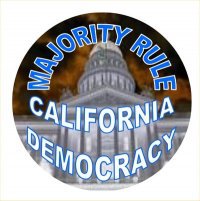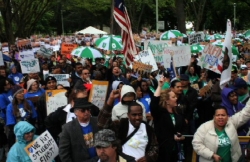Majority Vote Budget Initiative qualifies for ballot
How would you balance the budget? Take the Next10 budget challenge
By Miriam Raftery
 May 14, 2010 (Sacramento) – Facing a budget deficit of over $20 billion, today Governor Schwarzenegger proposed deep new budget cuts. The Governor proposes the complete elimination of the CAL-Works program (which will impact over 80,000 low-income parents and their children in San Diego County), slash in-home care for seniors and the disabled (including 23,000 seniors and disabled persons in San Diego County), and sharply cut funds for the Healthy Families program, among other drastic measures.
May 14, 2010 (Sacramento) – Facing a budget deficit of over $20 billion, today Governor Schwarzenegger proposed deep new budget cuts. The Governor proposes the complete elimination of the CAL-Works program (which will impact over 80,000 low-income parents and their children in San Diego County), slash in-home care for seniors and the disabled (including 23,000 seniors and disabled persons in San Diego County), and sharply cut funds for the Healthy Families program, among other drastic measures.
Hoping to end budget gridlock, teachers, firefighters and nurses last week joined together to submit more than 1.1 million signatures and qualify a Majority Vote Budget Initiative for the November 2, 2010 election. “Late budgets hurt all Californians and the budget crisis is continuing to be the top issue in the state,” said Kay McVay, President Emeritus of the California Nurses Association, “This initiative will not end all of the gridlock, but it is a step in the right direction.”
 Democratic leaders now say it’s time to raise revenues in order to protect vulnerable Californians and prevent cuts in education, health and human services. But the Governor says he will refuse to sign any budget that raises taxes, even on the wealthiest 1% of Californians.
Democratic leaders now say it’s time to raise revenues in order to protect vulnerable Californians and prevent cuts in education, health and human services. But the Governor says he will refuse to sign any budget that raises taxes, even on the wealthiest 1% of Californians.
Last year, Democrats tried to prevent deep cuts to education and social services by passing a budget that included some revenue increases. But Governor Schwarzenegger vetoed the measure. Republicans have consistently refused to vote for any tax increase proposed by Democrats (such as a wellhead tax on oil extraction, which could generate billions in revenues as it does in Alaska or Oklahoma) and have also blocked most fee increases.
 Republicans contend the budget should be balanced solely through spending cuts. While GOP candidates have campaigned on eliminating “waste, fraud and abuse” and "bloated bureaucracy," recent GOP proposals include reducing state workers’ pensions, cutting social safety net programs for the poor, and now eliminating all Cal-Works programs statewide, including welfare-to-work job training, nutrition and more. Three-fourths (75%) of all Cal-Works recipients are children.
Republicans contend the budget should be balanced solely through spending cuts. While GOP candidates have campaigned on eliminating “waste, fraud and abuse” and "bloated bureaucracy," recent GOP proposals include reducing state workers’ pensions, cutting social safety net programs for the poor, and now eliminating all Cal-Works programs statewide, including welfare-to-work job training, nutrition and more. Three-fourths (75%) of all Cal-Works recipients are children.
 Amid the state's worst fiscal crisis ever, the California Republican Party has proposed even more hefty tax cuts, arguing that cutting taxes will stop businesses from leaving California, create jobs, boosting the economy over the long-term.
Amid the state's worst fiscal crisis ever, the California Republican Party has proposed even more hefty tax cuts, arguing that cutting taxes will stop businesses from leaving California, create jobs, boosting the economy over the long-term.
"Democrats' insistence on raising taxes is like the medieval doctor whose cure for everything was to draw more blood. Draining off more dollars from the private sector will only guarantee California's economic demise," a statement at the California Republican Party website reads.
 According to the state Franchise Tax Board, the percentage of taxes paid by corporations reporting net income fell by nearly half between 1981 and 2006. In 2007 and 2008 additional cuts in corporate taxes were passed by the Legislature, a move that dropped billions from state revenues.
According to the state Franchise Tax Board, the percentage of taxes paid by corporations reporting net income fell by nearly half between 1981 and 2006. In 2007 and 2008 additional cuts in corporate taxes were passed by the Legislature, a move that dropped billions from state revenues.
Whether more tax cuts would grow the economy long-term remains to be seem. Meannwhile, the CRP offers no solution to help seniors, children, the disabled and others who will be harmed by the Governor's proposed budget.
Last year, to obtain a single Republican vote needed for the budget, Democrats had to agree to millions of dollars in corporate tax cuts and a run-off primary initiative. While both sides haggled to reach a deal, the state was left unable to pay its bills and issued IOUs, causing financial hardship to many. Such impasses have resulted in repeated stalemates in getting any budget passed, since California is one of only three states which requires a 2/3 majority to pass a budget.
 Supporters of the Majority Vote Budget Initiative contend that it’s needed to prevent a minority party from obstructing passage of a state budget. The Majority Vote Budget Initiative would require the state budget to be passed with a simple majority, however a two-thirds vote would still be needed for any tax increase, providing protection to taxpayers. Also under the measure, if legislators fail to pass a budget on time, they don’t get paid--and can’t pay themselves back later.
Supporters of the Majority Vote Budget Initiative contend that it’s needed to prevent a minority party from obstructing passage of a state budget. The Majority Vote Budget Initiative would require the state budget to be passed with a simple majority, however a two-thirds vote would still be needed for any tax increase, providing protection to taxpayers. Also under the measure, if legislators fail to pass a budget on time, they don’t get paid--and can’t pay themselves back later.
“It’s time to end the gridlock, backroom deals and political games in California’s dysfunctional budget process,” said Willie Pelote, Assistant Director of the American Federations of State, County and Municipal Employees (ASFCME) International.
 “Turning in these signatures is an important first step towards fixing a broken budget process,” said Dennis Smith, Secretary Treasurer of the California Federation of Teachers.CFT led a march of more than 7,500 to the State Capitol in March, calling for increased funding for education and other public services.
“Turning in these signatures is an important first step towards fixing a broken budget process,” said Dennis Smith, Secretary Treasurer of the California Federation of Teachers.CFT led a march of more than 7,500 to the State Capitol in March, calling for increased funding for education and other public services.
Other supporters of the measure include California Faculty Association, California Professional Firefighters, California School Employees Association, California Treasurer Bill Lockyer, California State Assembly Speaker John A. Pérez, and California State Senate President Pro Tem Darrel Steinberg.
For more information on the Yes on the Majority Vote Budget Initiative, see www.EndBudgetGridlock.com.
Republicans, meanwhile, have countered by qualifying a measure for the ballot that would make it harder for the Legislature to raise fees to balance the budget. Unlike raising taxes, which requires 2/3 of the legislators, fee increases currently require a simple majority. The proposed initiative would raise the level required for fee hikes to a 2/3 majority, giving the minority party power to block both fee increases and taxes.
A new nonpartisan site, California Budget Project (www.cbp.org) provides charts, graphs and other information to educate voters about our state’s expenses and revenues. Polls indicate that only 6% of adults in California know that K-12 education is the biggest item in the budget and that income taxes are the largest source of state revenues. Many are also surprised to learn that corporate taxes have fallen by nearly half since 1981. A report titled “Searching for Balance” provides a wealth of information.
At a recent budget workshop in San Diego open to the public, many residents expressed outrage to learn that their legislators approved cuts in in-home care for seniors and the disabled, while refusing to consider any form or revenue increase.
 Cutting fat from the budget is not as easy as it sounds. Many expenditures are mandated by the federal government or by initiatives passed by California voters. Cutting spending significantly without cutting education or social services is also not realistic.
Cutting fat from the budget is not as easy as it sounds. Many expenditures are mandated by the federal government or by initiatives passed by California voters. Cutting spending significantly without cutting education or social services is also not realistic.
In the 2010-2011 budget, education accounts for 56.9% of the budget. Health and human services is another 25%. Corrections and rehabilition (including prisons) takes 9.5%. The entire legislative, judicial and executive branches combined account for just 3.4% of the budget.The remaining sliver is divided among resources (2.1%, state and consumer services (0.7%), business, transportation and housing (1.1%), general government (1.3%), environmental protection (0.1%), labor and workforce development including jobs training (0.1%).
How would you balance the budget? Take the “Next 10” California budget challenge, an interactive program that lets you make choices in spending and cost-cutting, to see if you can do a better job than legislators at managing our state's finances.







Recent comments